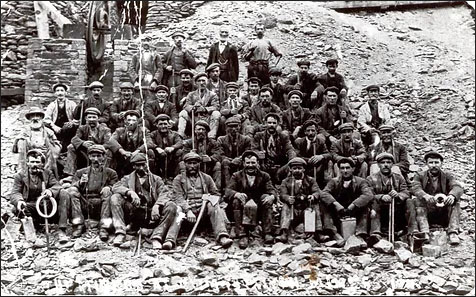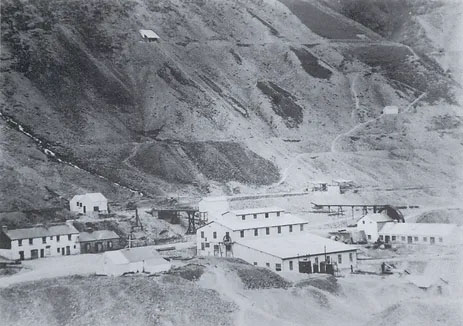History of the Cwmystwyth Mines
The Cwmystwyth Mines probably constitute
the most important mining site in central Wales, and just like many other
sites have something of a chequered history making fortunes for some while
bankrupting others.
Early
Mining
With an absence of recorded history much of what we know is due to the
excellent work of Simon Timberlake and the Early Mines Research Group.
Earliest mining is on on Copa Hill where the Comet Lode is exposed in an
Opencast. Here mining has been carbon dated to around 2100 cal BC,
although it may be even earlier. The period of mining ranges from then to
around 1600 cal BC, all of this within the Early Bronze Age. Mining then
ceases as the oxidised copper ores near outcrop become exhausted, but
also, more importantly, as the workings become flooded, despite attempts
(with use of wooden launders etc) to drain them. It must be emphasised
that early mining activities were attracted by the ease of extraction
rather than the abundance of reserves. An artefact has been discovered at
the foot of Copa Hill (probably from a grave) that provides a possible
link with Beaker prospectors, and perhaps even the very start of mining at
the end of the 3rd millennium BC.
E.M.R.G. palaeoenvironmental investigations
of the blanket peat on Copa Hill suggests that there is also Roman mining
for lead (probably during 1st-2nd century AD). Although no Roman workings
have been found in that location, a Roman lead bole (i.e. a lead smelting
hearth) was uncovered at the foot of Copa Hill.
We next have evidence for Early Medieval mining, as suggested by the
ancient leat for hushing on Copa Hill, plus some evidence for a Medieval
prospecting shaft within the Comet Lode opencast, and several lead
smelting hearths at Banc Tynddol, at the foot of Copa Hill. However, there
is no concrete evidence yet for early mining on the Graig Fawr, although
John Leland (16th century) and later on Lewis Morris thought that this was
where the Cistercians (i.e. Strata Florida Abbey) had their interests.
There is a charter of 1184 giving to the church many thousands of acres of
lands which specifically mentions "possessions under the land" and "the
fatness of the possessions below"
Later
Mining
As can be seen from above the later phase of early mining was controlled
by the Abbot of Strata Florida Abbey, which would have continued up until
the dissolution of the monasteries by Henry the Eighth in 1536. Following
this little was probably done until Elizabeth 1st took the throne and
formed the Society of Mines Royal which was the start of the first
intensive mining. Under the society there were several lease holders
including the ubiquitous Sir Hugh Myddleton and Thomas Bushell.
In 1693 the Mines Royal Act ended the monopoly of the society and laid the
way open to the Company of mine Adventurers under Mackworth and Waller.
In 1759 the mines passed into the hands of Chauncey Townsend who engaged
the services of Thomas Bonsall from Derbyshire to manage the mines.
Bonsall stayed on after the death of Townsend in 1770 working the mines
for Townsends son who inherited the lease, later in 1785 he took on the
lease himself.
Bonsall did quite well out of the job regularly earning £2000 a year out
of Cwmystwyth, Castell, and Rhiwrugos mines which he also owned.
A lot of the well known works are attributable to Bonsall, and towards the
end of the 18th century his earnings had reached £2000 to £3000 a year
from Kingside and Pughes mines alone. He was also responsible for Bonsalls
level and Level Fawr.
Bonsall died in 1807 and the lease passed to his son, and then was taken
over by the Alderson Brothers from Swaledale and James Raw who has local
descendants.
Unfortunately the price of lead plunged in the 1830s and the Aldersons
were declared bankrupt. The lease was then taken by Lewis Pugh of
Aberystwyth who was incredibly lucky as metal prices started to soar
immediately and he made a fortune from stocks of ore in hand when he took
over the lease.
In 1848 John Taylor of Norwich took over the mines, another for his
collection. The mine was being worked on the cost book system and in 1885
after a period of poor output the mines passed to a new company ‘The
Cwmystwyth Company’. Almost immediately the mine was split between two
concerns ‘The New Cwmystwyth Company’ and ‘The Kingside Mining Company’
who worked the mines until 1892 and 1893 respectively.
In 1900 the mines were taken over by The Cwmystwyth Mining Company Ltd
under Henry Gammon who poured a fortune into development work and
investment in new plant and machinery; however the new company struggled
badly to make it pay. In 1905 the company was re-formed as Kingside Zinc Blende Ltd but still struggled to turn a profit. By 1909 Gammon had blown
all his money in the place but managed to attract Brunner Mond to invest
in his existing company.
|
In 1912
the mine was again split into two sections, with part being taken over by
The May Mining Company formed by one of the old mine captains John Howell
Evans in partnership with a Charles Stocks. This company is notable in one
of the few metal mining concerns that used Kell Drills developed by Moses
Kellow of the Kelldrill Works at Croesor Slate Mine near Blaenau
Ffestiniog.
Kellow was another Cornishman in Wales being born at Delabole in 1862.
Besides being the owner of the Kelldrill Company he was manager of the
quarry. These drills worked on hydraulic pressure using water, and are
arguably the most powerful rock drills ever produced. High pressure water
acted on a Pelton turbine, later a reaction turbine, which drove the shaft
of the drill by elliptic gears. The drill developed 55h.p. and was twice
as efficient as a modern rock drill. Unfortunately they were very
difficult to control and never caught on.
History was to repeat itself however and these two companies went to the
wall in 1915 and 1916 respectively.
In 1916 two gentlemen named Thomas and Stocks managed to form a new
company Cwm Ystwyth Mines Ltd which struggled on until 1923 when the mines
passed into the hands of the British Metal Corporation.
In 1925 the mines were being worked by a partnership of a Craig and
Herbert and finally The Gallois Lead and Zinc Mines Ltd until 1950 when
the mines were finally abandoned.
Eventually the ownership of the land and mines passed into the hands of
the Crown Estate who in 2012 spent a great deal of money consolidating the
remaining buildings, and then in 2013 the whole site was acquired by
Cambrian Mines Trust - the present owners. A lot of research was done
by the late Simon Hughes which was well documented in his various works.
he was also active in a lot of the original explorations and documenting
of the underground workings
Pre-industrial
Archaeology of Cwmystwyth
|
|
Acid Mine Discharge
The Cwmystwyth mines are a major contributor to
toxic metals pollution in the Afon Ystwth catchment, currently discharging
about 2.4 tons of lead and 16.7 tons of zinc per annum from adit drainage
and percolation through the tips. These amounts are far above those
allowed by legislation and the principal mine area is hence currently
under study by Natural Resiurces Wales and the Mines Remediation Authority
to design and engineer an appropriate treatment plant to reduce pollution
to acceptable levels. The directive for this work is that the
archaeological and biodiversity heritage of the site, and its designations
as SSSI and SAM, should be as far as possible safeguarded. The Trust has
been kept fully informed by the Authorities and has been able to
contribute useful design data from its surveys of the workings
underground.
|

